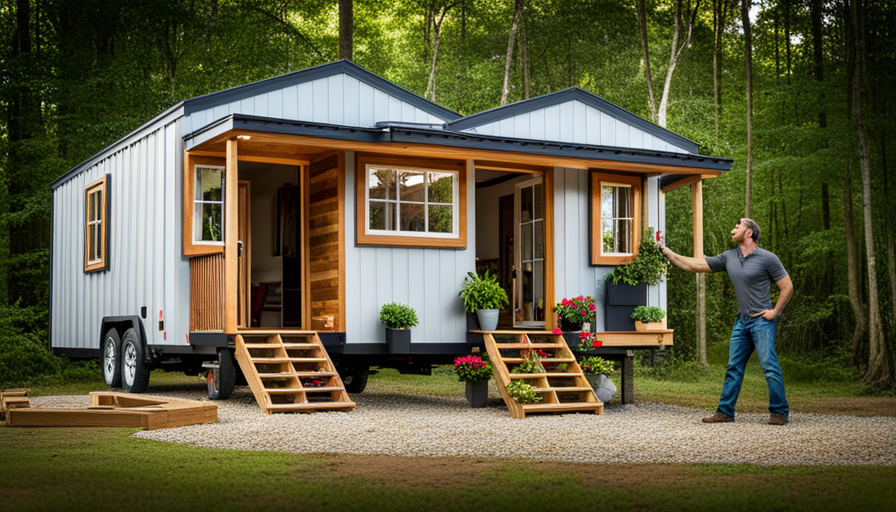Have you ever wondered about the size of a truck needed to tow a tiny house?
Well, buckle up, because I’m about to take you on a journey through the world of towing.
Picture this: you’re ready to hit the road with your cozy little abode in tow, but you’re not quite sure if your truck can handle the weight.
Fear not, my friend, for I am here to guide you through the intricacies of choosing the perfect towing vehicle.
In this article, we will delve into the nitty-gritty details of understanding the weight and size of your tiny house, researching different trucks’ towing capacities, and considering the factors that will help you make the right truck choice.
We’ll even go the extra mile and consult with experts and professionals to ensure that you’re armed with the best advice.
But that’s not all! We’ll also test drive and evaluate truck performance, explore safety and legal requirements, and discuss the maintenance and care needed for your towing vehicle.
So, if you’re ready to embark on this towing adventure, let’s get started and find out just how big of a truck you need to tow your tiny house!
Key Takeaways
- Understanding the weight and size of the tiny house is crucial before choosing a truck for towing.
- Consider factors like towing capacity, fuel efficiency, reliability, and durability when selecting a truck.
- Engine power and torque are essential for towing heavy loads.
- Suspension, braking systems, and upgraded brakes are important for stability and control while towing.
Understanding the Weight and Size of Your Tiny House
You’ll need to understand the weight and size of your tiny house before deciding on the right truck to tow it. Weighing your options and calculating the towing capacity are crucial steps in ensuring a safe and successful towing experience.
To determine the weight of your tiny house, you can consult the manufacturer’s specifications or use a scale specifically designed for weighing trailers. Additionally, consider the size of your tiny house, including its length, width, and height, as this will impact the stability and maneuverability of the truck.
Once you have these measurements, you can start researching the towing capacity of different trucks. This information will help you narrow down your choices and find a truck that can handle the weight and size of your tiny house, ensuring a smooth and efficient towing process.
Researching the Towing Capacity of Different Trucks
When it comes to finding the right vehicle for pulling a small home on wheels, it’s essential to delve into the research on how various trucks handle towing capacities. To help you make an informed decision, here is a breakdown of three key factors to consider:
-
Towing Capacity Comparison: Compare the towing capacities of different trucks to ensure they can handle the weight of your tiny house. Look for trucks with higher towing capacities to provide a safety buffer.
-
Fuel Efficiency Analysis: Consider the fuel efficiency of the trucks you’re researching. Opting for a truck that offers good fuel efficiency can help save you money in the long run, especially if you plan on traveling long distances.
-
Reliability and Durability: Look for trucks known for their reliability and durability. You want a truck that can handle the demands of towing a tiny house without breaking down or causing unnecessary stress.
Considering these factors will help you find the right truck to tow your tiny house.
In the next section, we will explore considerations for choosing the right truck without compromising safety or performance.
Considerations for Choosing the Right Truck
When choosing the right truck for towing a tiny house, there are several key considerations to keep in mind.
First, it’s important to consider the engine power and torque of the truck. A powerful engine will provide the necessary strength to tow heavy loads, while torque is crucial for tackling steep inclines.
Additionally, the suspension and braking systems should be taken into account, as they play a crucial role in maintaining stability and control while towing.
Finally, considering the transmission options is important, as a transmission with a high number of gears can provide better fuel efficiency and a smoother towing experience.
Engine Power and Torque
With sufficient engine power and torque, a truck can easily tow a tiny house. When considering the engine power, it’s important to prioritize reliability and fuel efficiency. A reliable engine ensures that the truck can handle the load without any breakdowns or malfunctions. Additionally, a fuel-efficient engine helps reduce the overall cost of towing by minimizing the amount of fuel consumed during the journey.
In terms of engine power and torque, there are a few key factors to consider. Horsepower: A higher horsepower rating indicates greater engine power, allowing the truck to tow the tiny house more effortlessly. Torque: High torque enables the truck to generate the necessary pulling force, especially when tackling inclines or rough terrains. Transmission: Choosing a truck with a transmission that offers a wide range of gears can optimize engine power delivery and improve towing capabilities.
Considering these factors will ensure that the truck has the necessary engine power and torque to tow a tiny house efficiently. Moving from engine considerations to the next section on suspension and braking systems, it’s crucial to evaluate these components for a well-rounded towing experience.
Suspension and Braking Systems
To ensure a smooth and safe towing experience, it’s essential to have a suspension and braking system that can handle the weight and demands of the load.
Proper suspension maintenance is crucial as it helps maintain stability and control while towing a tiny house. Regular inspections and adjustments should be made to ensure that the suspension components are in good working condition.
Additionally, upgrading the braking system can greatly improve towing safety. Upgraded brakes provide better stopping power, reducing the risk of accidents and allowing for better control of the load.
When considering a truck to tow a tiny house, it’s important to factor in the suspension and braking system capabilities, as they play a significant role in ensuring a safe and enjoyable towing experience.
Now, let’s move on to the next section and discuss transmission options.
Transmission Options
Consider the various transmission options available for your towing needs, as using an automatic transmission can increase fuel efficiency by up to 10%. When it comes to towing a tiny house, having the right transmission type can make a significant difference.
Automatic transmissions are generally preferred for towing purposes due to their ability to optimize gear shifts and provide a smoother driving experience. They also offer better fuel efficiency compared to manual transmissions. However, it’s essential to choose the right transmission for your specific towing requirements. Factors such as the weight of the tiny house and the terrain you’ll be navigating should be taken into consideration.
Consulting with experts and professionals who specialize in towing can provide valuable insights and help you make an informed decision. Whether you opt for an automatic or manual transmission, it’s crucial to ensure it’s capable of handling the load and providing optimal fuel efficiency.
Consulting with Experts and Professionals
When consulting with experts and professionals, they’ll give you valuable advice on how big a truck you’ll need to tow a tiny house. Here are some key points they may discuss:
-
Weight and size of the tiny house: Experts will assess the dimensions and weight of your tiny house to determine the appropriate truck size.
-
Towing capacity: They’ll consider the towing capacity of different trucks and match it with the weight of your tiny house.
-
Cost implications: Professionals will discuss the financial aspects, including the price range of trucks suitable for towing a tiny house.
-
Environmental impact: They’ll also highlight the environmental implications of using a larger truck and may suggest eco-friendly alternatives.
-
Safety considerations: Experts will emphasize the importance of safety, such as proper hitching, braking, and stability control.
By consulting with experts and professionals, you can make an informed decision on the right truck size for towing your tiny house. Once you have that information, you can move on to test driving and evaluating truck performance.
Test Driving and Evaluating Truck Performance
Once you’ve consulted with experts and professionals, it’s time to hop behind the wheel and put the truck through its paces to assess its performance in real-world conditions.
The test drive evaluation is crucial in determining whether the truck is capable of towing a tiny house safely and efficiently. During the test drive, I focus on various aspects of truck performance measurement, such as acceleration, braking, stability, and handling.
I pay close attention to how the truck handles the weight of the tiny house and whether it maintains control on different terrains and inclines. Additionally, I assess its towing capacity, ensuring it meets the necessary requirements for the tiny house.
By thoroughly evaluating the truck’s performance, I can confidently move forward knowing that it is capable of safely towing the tiny house.
Speaking of safety and legal requirements, it’s important to consider certain factors to ensure a secure and compliant journey.
Safety and Legal Requirements
To ensure a safe and compliant journey, it’s crucial for you to prioritize understanding the safety regulations and legal requirements involved in towing a tiny house with a truck. These regulations vary by country and state, so it is important to research and comply with the specific rules in your area. Safety regulations typically cover aspects such as weight limits, trailer braking systems, and lighting requirements. Additionally, you need to ensure that your towing equipment, including the hitch and safety chains, meet the necessary standards. Failure to comply with these regulations can result in fines, penalties, and even accidents. To emphasize the importance of safety, let’s take a look at the emotional impact of not following these regulations:
| Situation | Emotional Response |
|---|---|
| Complying with regulations | Peace of Mind |
| Ignoring regulations | Fear and Anxiety |
| Accidents due to non-compliance | Guilt and Regret |
Understanding and following safety regulations is essential for a worry-free journey. In the next section, we will discuss maintenance and care for your towing vehicle.
Maintenance and Care for Your Towing Vehicle
Taking proper care of your towing vehicle is crucial for ensuring a smooth and safe journey. Statistics show that regular maintenance can decrease the risk of breakdowns by up to 75%.
When it comes to maintaining your towing vehicle, there are a few key maintenance tips to keep in mind. First, make sure to regularly check and change the oil and filters to keep the engine running smoothly. Additionally, inspect the tires for proper inflation and wear, as well as ensure the brakes are in good working condition.
Another important aspect of maintenance is keeping an eye on the transmission fluid and coolant levels. By staying on top of these maintenance tasks, you can prevent common towing vehicle issues such as engine overheating, tire blowouts, and brake failures.
Frequently Asked Questions
How long does it typically take to research the towing capacity of different trucks?
On average, researching the towing capacity of different trucks can take anywhere from a few hours to several days, depending on the depth of research required. It involves gathering information about various truck models, checking their specifications, and understanding their towing capabilities.
This process may also involve consulting experts, reading reviews, and comparing different options. It’s important to invest time in this research to ensure you choose a truck that can safely and efficiently tow your tiny house.
What are some common mistakes people make when choosing the right truck for towing a tiny house?
One common mistake people make when choosing the right truck for towing a tiny house is underestimating the importance of the towing capacity. It’s like trying to fit a square peg in a round hole.
Without considering this crucial factor, you risk damaging your truck and endangering yourself on the road.
Other important factors to consider include the weight distribution, trailer brakes, and stability control.
Don’t let these mistakes turn your tiny house dreams into a nightmare.
Are there any specific experts or professionals who specialize in towing tiny houses that I should consult with?
Experts and professionals who specialize in towing tiny houses are invaluable resources when it comes to making the right choice. Their expertise and experience can help you avoid common mistakes and ensure a smooth tow.
Consultation with these professionals will provide you with valuable insights on the specific requirements and considerations for towing tiny houses. Their knowledge and analytical approach will guide you in finding the most suitable truck for your towing needs.
What are some key factors to consider when test driving and evaluating the performance of a potential towing vehicle?
When test driving and evaluating the performance of a potential towing vehicle, there are several key factors to consider.
Factors to consider include the engine power, towing capacity, and stability of the vehicle.
Test driving allows me to assess the vehicle’s acceleration, braking, and handling while towing. It’s important to pay attention to how the vehicle handles on different terrains and in various weather conditions.
Evaluating the performance ensures that the towing vehicle can safely and efficiently handle the weight and size of a tiny house.
How often should I schedule maintenance for my towing vehicle to ensure its longevity and optimal performance?
Towing vehicle maintenance frequency is crucial for ensuring longevity and optimal performance. Regular maintenance is of utmost importance to keep your towing vehicle in top shape. By scheduling maintenance at recommended intervals, you can address any potential issues before they become major problems.
This includes regular oil changes, tire rotations, and inspections of brake systems, suspension, and towing components. Consistent maintenance will not only extend the life of your vehicle but also enhance its towing capabilities.
Conclusion
After carefully considering the weight and size of your tiny house, researching the towing capacity of different trucks, and consulting with experts, you’re now ready to make a decision.
The test drive and evaluation of truck performance will help you finalize your choice. Remember, safety and legal requirements shouldn’t be overlooked.
Once you have your towing vehicle, regular maintenance and care will ensure a smooth journey. So, buckle up because with the right truck, you’ll be towing your tiny house with the grace of a swan gliding through calm waters.
Hi, I’m Emma. I’m the Editor in Chief of Tiny House 43, a blog all about tiny houses. While tree houses are often associated with childhood, they can be the perfect adult retreat. They offer a cozy space to relax and unwind, surrounded by nature. And since they’re typically built on stilts or raised platforms, they offer stunning views that traditional homes simply can’t match. If you’re looking for a unique and romantic getaway, a tree house tiny house might just be the perfect option.










